Li Fei-Fei
Stanford University
Spatial Mental Modeling from Limited Views
Jun 26, 2025Abstract:Can Vision Language Models (VLMs) imagine the full scene from just a few views, like humans do? Humans form spatial mental models, internal representations of unseen space, to reason about layout, perspective, and motion. Our new MindCube benchmark with 21,154 questions across 3,268 images exposes this critical gap, where existing VLMs exhibit near-random performance. Using MindCube, we systematically evaluate how well VLMs build robust spatial mental models through representing positions (cognitive mapping), orientations (perspective-taking), and dynamics (mental simulation for "what-if" movements). We then explore three approaches to help VLMs approximate spatial mental models, including unseen intermediate views, natural language reasoning chains, and cognitive maps. The significant improvement comes from a synergistic approach, "map-then-reason", that jointly trains the model to first generate a cognitive map and then reason upon it. By training models to reason over these internal maps, we boosted accuracy from 37.8% to 60.8% (+23.0%). Adding reinforcement learning pushed performance even further to 70.7% (+32.9%). Our key insight is that such scaffolding of spatial mental models, actively constructing and utilizing internal structured spatial representations with flexible reasoning processes, significantly improves understanding of unobservable space.
UAD: Unsupervised Affordance Distillation for Generalization in Robotic Manipulation
Jun 10, 2025Abstract:Understanding fine-grained object affordances is imperative for robots to manipulate objects in unstructured environments given open-ended task instructions. However, existing methods of visual affordance predictions often rely on manually annotated data or conditions only on a predefined set of tasks. We introduce UAD (Unsupervised Affordance Distillation), a method for distilling affordance knowledge from foundation models into a task-conditioned affordance model without any manual annotations. By leveraging the complementary strengths of large vision models and vision-language models, UAD automatically annotates a large-scale dataset with detailed $<$instruction, visual affordance$>$ pairs. Training only a lightweight task-conditioned decoder atop frozen features, UAD exhibits notable generalization to in-the-wild robotic scenes and to various human activities, despite only being trained on rendered objects in simulation. Using affordance provided by UAD as the observation space, we show an imitation learning policy that demonstrates promising generalization to unseen object instances, object categories, and even variations in task instructions after training on as few as 10 demonstrations. Project website: https://unsup-affordance.github.io/
Exploring Diffusion Transformer Designs via Grafting
Jun 06, 2025Abstract:Designing model architectures requires decisions such as selecting operators (e.g., attention, convolution) and configurations (e.g., depth, width). However, evaluating the impact of these decisions on model quality requires costly pretraining, limiting architectural investigation. Inspired by how new software is built on existing code, we ask: can new architecture designs be studied using pretrained models? To this end, we present grafting, a simple approach for editing pretrained diffusion transformers (DiTs) to materialize new architectures under small compute budgets. Informed by our analysis of activation behavior and attention locality, we construct a testbed based on the DiT-XL/2 design to study the impact of grafting on model quality. Using this testbed, we develop a family of hybrid designs via grafting: replacing softmax attention with gated convolution, local attention, and linear attention, and replacing MLPs with variable expansion ratio and convolutional variants. Notably, many hybrid designs achieve good quality (FID: 2.38-2.64 vs. 2.27 for DiT-XL/2) using <2% pretraining compute. We then graft a text-to-image model (PixArt-Sigma), achieving a 1.43x speedup with less than a 2% drop in GenEval score. Finally, we present a case study that restructures DiT-XL/2 by converting every pair of sequential transformer blocks into parallel blocks via grafting. This reduces model depth by 2x and yields better quality (FID: 2.77) than other models of comparable depth. Together, we show that new diffusion model designs can be explored by grafting pretrained DiTs, with edits ranging from operator replacement to architecture restructuring. Code and grafted models: https://grafting.stanford.edu
RAGEN: Understanding Self-Evolution in LLM Agents via Multi-Turn Reinforcement Learning
Apr 24, 2025Abstract:Training large language models (LLMs) as interactive agents presents unique challenges including long-horizon decision making and interacting with stochastic environment feedback. While reinforcement learning (RL) has enabled progress in static tasks, multi-turn agent RL training remains underexplored. We propose StarPO (State-Thinking-Actions-Reward Policy Optimization), a general framework for trajectory-level agent RL, and introduce RAGEN, a modular system for training and evaluating LLM agents. Our study on three stylized environments reveals three core findings. First, our agent RL training shows a recurring mode of Echo Trap where reward variance cliffs and gradient spikes; we address this with StarPO-S, a stabilized variant with trajectory filtering, critic incorporation, and decoupled clipping. Second, we find the shaping of RL rollouts would benefit from diverse initial states, medium interaction granularity and more frequent sampling. Third, we show that without fine-grained, reasoning-aware reward signals, agent reasoning hardly emerge through multi-turn RL and they may show shallow strategies or hallucinated thoughts. Code and environments are available at https://github.com/RAGEN-AI/RAGEN.
Chain-of-Modality: Learning Manipulation Programs from Multimodal Human Videos with Vision-Language-Models
Apr 17, 2025Abstract:Learning to perform manipulation tasks from human videos is a promising approach for teaching robots. However, many manipulation tasks require changing control parameters during task execution, such as force, which visual data alone cannot capture. In this work, we leverage sensing devices such as armbands that measure human muscle activities and microphones that record sound, to capture the details in the human manipulation process, and enable robots to extract task plans and control parameters to perform the same task. To achieve this, we introduce Chain-of-Modality (CoM), a prompting strategy that enables Vision Language Models to reason about multimodal human demonstration data -- videos coupled with muscle or audio signals. By progressively integrating information from each modality, CoM refines a task plan and generates detailed control parameters, enabling robots to perform manipulation tasks based on a single multimodal human video prompt. Our experiments show that CoM delivers a threefold improvement in accuracy for extracting task plans and control parameters compared to baselines, with strong generalization to new task setups and objects in real-world robot experiments. Videos and code are available at https://chain-of-modality.github.io
Re-thinking Temporal Search for Long-Form Video Understanding
Apr 03, 2025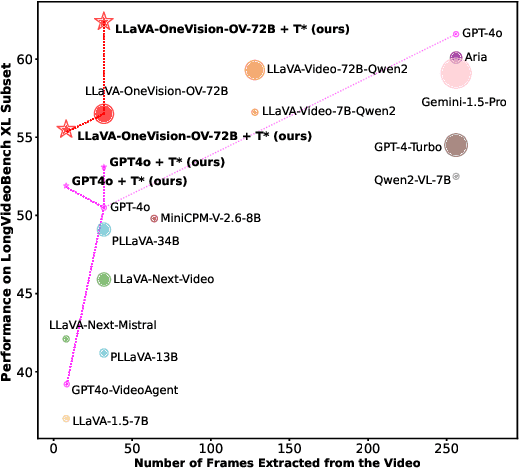
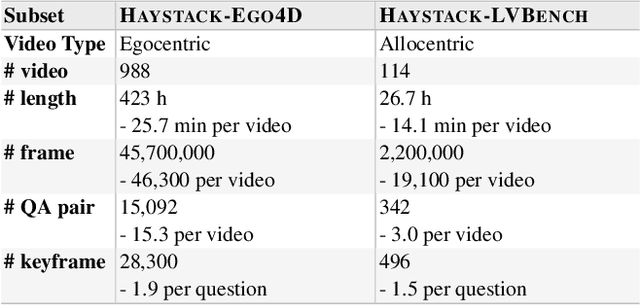
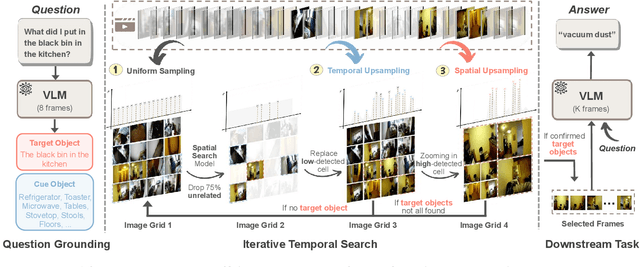
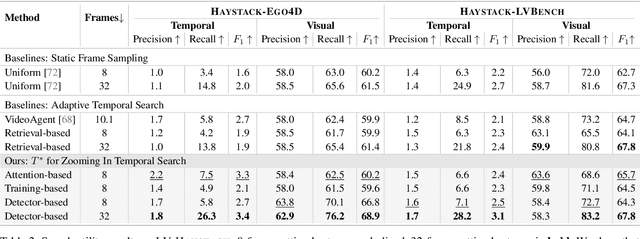
Abstract:Efficient understanding of long-form videos remains a significant challenge in computer vision. In this work, we revisit temporal search paradigms for long-form video understanding, studying a fundamental issue pertaining to all state-of-the-art (SOTA) long-context vision-language models (VLMs). In particular, our contributions are two-fold: First, we formulate temporal search as a Long Video Haystack problem, i.e., finding a minimal set of relevant frames (typically one to five) among tens of thousands of frames from real-world long videos given specific queries. To validate our formulation, we create LV-Haystack, the first benchmark containing 3,874 human-annotated instances with fine-grained evaluation metrics for assessing keyframe search quality and computational efficiency. Experimental results on LV-Haystack highlight a significant research gap in temporal search capabilities, with SOTA keyframe selection methods achieving only 2.1% temporal F1 score on the LVBench subset. Next, inspired by visual search in images, we re-think temporal searching and propose a lightweight keyframe searching framework, T*, which casts the expensive temporal search as a spatial search problem. T* leverages superior visual localization capabilities typically used in images and introduces an adaptive zooming-in mechanism that operates across both temporal and spatial dimensions. Our extensive experiments show that when integrated with existing methods, T* significantly improves SOTA long-form video understanding performance. Specifically, under an inference budget of 32 frames, T* improves GPT-4o's performance from 50.5% to 53.1% and LLaVA-OneVision-72B's performance from 56.5% to 62.4% on LongVideoBench XL subset. Our PyTorch code, benchmark dataset and models are included in the Supplementary material.
WorldScore: A Unified Evaluation Benchmark for World Generation
Apr 01, 2025Abstract:We introduce the WorldScore benchmark, the first unified benchmark for world generation. We decompose world generation into a sequence of next-scene generation tasks with explicit camera trajectory-based layout specifications, enabling unified evaluation of diverse approaches from 3D and 4D scene generation to video generation models. The WorldScore benchmark encompasses a curated dataset of 3,000 test examples that span diverse worlds: static and dynamic, indoor and outdoor, photorealistic and stylized. The WorldScore metrics evaluate generated worlds through three key aspects: controllability, quality, and dynamics. Through extensive evaluation of 19 representative models, including both open-source and closed-source ones, we reveal key insights and challenges for each category of models. Our dataset, evaluation code, and leaderboard can be found at https://haoyi-duan.github.io/WorldScore/
Repurposing 2D Diffusion Models with Gaussian Atlas for 3D Generation
Mar 20, 2025Abstract:Recent advances in text-to-image diffusion models have been driven by the increasing availability of paired 2D data. However, the development of 3D diffusion models has been hindered by the scarcity of high-quality 3D data, resulting in less competitive performance compared to their 2D counterparts. To address this challenge, we propose repurposing pre-trained 2D diffusion models for 3D object generation. We introduce Gaussian Atlas, a novel representation that utilizes dense 2D grids, enabling the fine-tuning of 2D diffusion models to generate 3D Gaussians. Our approach demonstrates successful transfer learning from a pre-trained 2D diffusion model to a 2D manifold flattened from 3D structures. To support model training, we compile GaussianVerse, a large-scale dataset comprising 205K high-quality 3D Gaussian fittings of various 3D objects. Our experimental results show that text-to-image diffusion models can be effectively adapted for 3D content generation, bridging the gap between 2D and 3D modeling.
Flow to the Mode: Mode-Seeking Diffusion Autoencoders for State-of-the-Art Image Tokenization
Mar 14, 2025Abstract:Since the advent of popular visual generation frameworks like VQGAN and latent diffusion models, state-of-the-art image generation systems have generally been two-stage systems that first tokenize or compress visual data into a lower-dimensional latent space before learning a generative model. Tokenizer training typically follows a standard recipe in which images are compressed and reconstructed subject to a combination of MSE, perceptual, and adversarial losses. Diffusion autoencoders have been proposed in prior work as a way to learn end-to-end perceptually-oriented image compression, but have not yet shown state-of-the-art performance on the competitive task of ImageNet-1K reconstruction. We propose FlowMo, a transformer-based diffusion autoencoder that achieves a new state-of-the-art for image tokenization at multiple compression rates without using convolutions, adversarial losses, spatially-aligned two-dimensional latent codes, or distilling from other tokenizers. Our key insight is that FlowMo training should be broken into a mode-matching pre-training stage and a mode-seeking post-training stage. In addition, we conduct extensive analyses and explore the training of generative models atop the FlowMo tokenizer. Our code and models will be available at http://kylesargent.github.io/flowmo .
Towards Fine-Grained Video Question Answering
Mar 10, 2025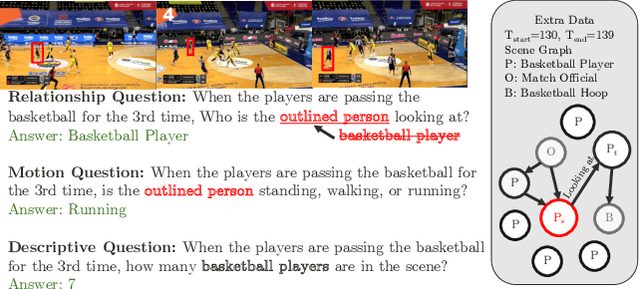


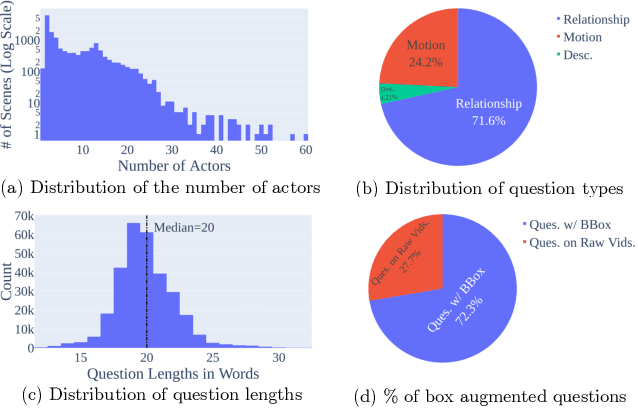
Abstract:In the rapidly evolving domain of video understanding, Video Question Answering (VideoQA) remains a focal point. However, existing datasets exhibit gaps in temporal and spatial granularity, which consequently limits the capabilities of existing VideoQA methods. This paper introduces the Multi-Object Multi-Actor Question Answering (MOMA-QA) dataset, which is designed to address these shortcomings by emphasizing temporal localization, spatial relationship reasoning, and entity-centric queries. With ground truth scene graphs and temporal interval annotations, MOMA-QA is ideal for developing models for fine-grained video understanding. Furthermore, we present a novel video-language model, SGVLM, which incorporates a scene graph predictor, an efficient frame retriever, and a pre-trained large language model for temporal localization and fine-grained relationship understanding. Evaluations on MOMA-QA and other public datasets demonstrate the superior performance of our model, setting new benchmarks for VideoQA.
 Add to Chrome
Add to Chrome Add to Firefox
Add to Firefox Add to Edge
Add to Edge